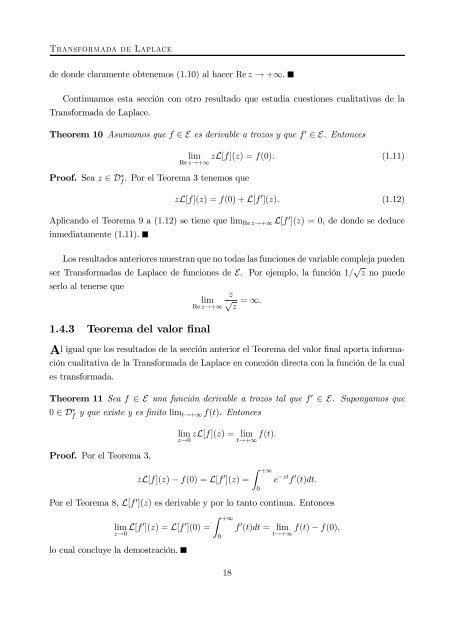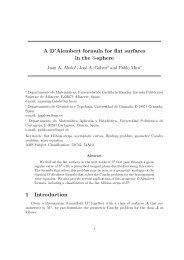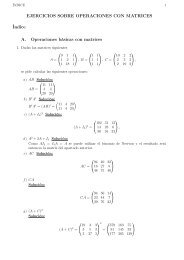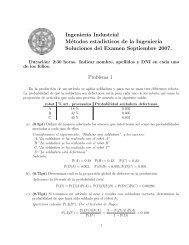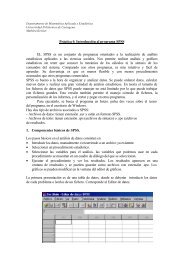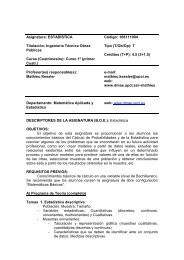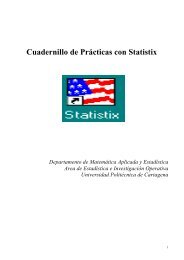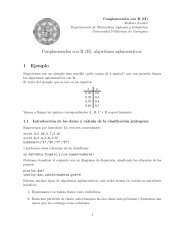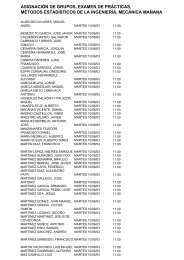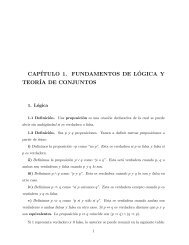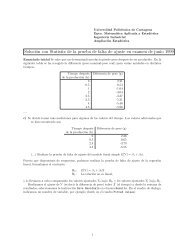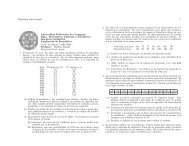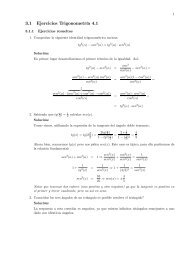Transformada de Laplace y sus aplicaciones a las ecuaciones ...
Transformada de Laplace y sus aplicaciones a las ecuaciones ...
Transformada de Laplace y sus aplicaciones a las ecuaciones ...
Create successful ePaper yourself
Turn your PDF publications into a flip-book with our unique Google optimized e-Paper software.
<strong>Transformada</strong> <strong>de</strong> <strong>Laplace</strong><br />
<strong>de</strong> don<strong>de</strong> claramente obtenemos (1.10) al hacer Re z → +∞.<br />
Continuamos esta sección con otro resultado que estudia cuestiones cualitativas <strong>de</strong> la<br />
<strong>Transformada</strong> <strong>de</strong> <strong>Laplace</strong>.<br />
Theorem 10 Asumamos que f ∈ E es <strong>de</strong>rivable a trozos y que f 0 ∈ E. Entonces<br />
Proof. Sea z ∈ D∗ f . Por el Teorema 3 tenemos que<br />
lim zL[f](z) =f(0). (1.11)<br />
Re z→+∞<br />
zL[f](z) =f(0) + L[f 0 ](z). (1.12)<br />
Aplicando el Teorema 9 a (1.12) se tiene que limRe z→+∞ L[f 0 ](z) =0, <strong>de</strong> don<strong>de</strong> se <strong>de</strong>duce<br />
inmediatamente (1.11).<br />
Losresultadosanterioresmuestranquenotodas<strong>las</strong>funciones<strong>de</strong>variablecomplejapue<strong>de</strong>n<br />
ser <strong>Transformada</strong>s <strong>de</strong> <strong>Laplace</strong> <strong>de</strong> funciones <strong>de</strong> E. Por ejemplo, la función 1/ √ z no pue<strong>de</strong><br />
serlo al tenerse que<br />
z<br />
√ = ∞.<br />
z<br />
lim<br />
Re z→+∞<br />
1.4.3 Teorema <strong>de</strong>l valor final<br />
Al igual que los resultados <strong>de</strong> la sección anterior el Teorema <strong>de</strong>l valor final aporta informacióncualitativa<strong>de</strong>la<strong>Transformada</strong><strong>de</strong><strong>Laplace</strong>enconexióndirectaconlafunción<strong>de</strong>lacual<br />
es transformada.<br />
Theorem 11 Sea f ∈ E una función <strong>de</strong>rivable a trozos tal que f 0 ∈ E. Supongamos que<br />
0 ∈ D∗ f yqueexisteyesfinito limt→+∞ f(t). Entonces<br />
lim zL[f](z) = lim<br />
z→0 t→+∞ f(t).<br />
Proof. Por el Teorema 3,<br />
zL[f](z) − f(0) = L[f 0 Z +∞<br />
](z) =<br />
0<br />
e −zt f 0 (t)dt.<br />
Por el Teorema 8, L[f 0 ](z) es <strong>de</strong>rivable y por lo tanto continua. Entonces<br />
lim<br />
z→0 L[f 0 ](z) =L[f 0 Z +∞<br />
](0) = f 0 (t)dt = lim f(t) − f(0),<br />
t→+∞<br />
lo cual concluye la <strong>de</strong>mostración.<br />
0<br />
18


